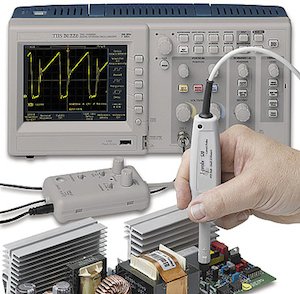I-Prober 520 Non Clamp Current Probe
Isolated and Non-Intrusive Current Probe
The Powertek I-Prober 520 is a non-contact non clamp current probe, allowing fast easy measurement of ac and dc currents in PCB tracks and cables.

Highlights
- Observe and measure current in a PCB track
- Make measurements using non-contact probing
- Suitable for observation and measurement of current in component leads and PCB tracks
- Wide dynamic range of 10mA to 20A pk to pk
- Wide bandwidth of DC to 5MHz
- Low noise equivalent to < 6mA rms at full bandwidth
- Minimal disturbance to circuit conditions, very low insertion impedance and stray capacitance
- Safety rated to 300V Cat II (600V Cat I)
- Suitable for connection to any oscilloscope
- High accuracy general purpose H-field probe
- Converts to a standard "closed magnetic circuit" current probe
Description
The Powertek I-Prober 520 is a non-contact non clamp current probe, allowing fast easy measurement of ac and dc currents in PCB tracks and cables. It works by placing the insulated tip of the probe onto a PCB track, the current flowing in the track can be observed and measured.
The I-Prober 520 probe is unlike any other current measurement device available. Calibrated measurement of current normally requires the current to be passed through a closed magnetic loop. Typically this is done using some form of split clamp device. Where this may be suitable for individual wires, it has limited use for measuring current in PCB tracks - often in high density pcb boards.
The I-Prober 520 current probes can be used with all oscilloscopes.
Specifications
*This is the noise level for current measurement using the Toroid attachment. For PCB track measurement the equivalent noise will depend upon the track width and gain setting but will be similar to the Toroid measurement figure for a track width of 0.5mm.
The I-Prober 520 consists of the current probe connected by 1.25 metres of cable to its signal conditioner. From there a further 0.5 metres of cable is terminated in a BNC connector for use with any normal oscilloscope.
The probe is powered through the signal conditioner by a small universal-voltage ac adaptor.
A clip on toroid assembly is also provided which converts the probe into a conventional "closed magnetic circuit" current probe for measurement of current in a wire
The signal conditioner provides the choice of three modes of operation along with bandwidth filters, an offset control and overload indicator.
It also incorporates the calibrator needed for measurement on PCB tracks of differing widths.
The unique feature of the I-Prober 520 is its ability to observe and measure currents flowing in PCB tracks by acting as a non-contact current probe.
The magnitude of the signal is critically related to its position relative to the conductor which means that the probe tip must be positioned carefully. The size of the conductor (e.g. the width of a PCB track) also has a significant effect.
This means that the sensitivity of the I-prober has to be adjusted to match the track width when quantitative measurements are required. A calibrator within the signal conditioner enables sensitivity adjustment in conjunction with a calibration graph.
The measurement result will also include other field effects present at the tip of the probe and not just that coming from the current through the conductor. This may include DC effects from adjacent magnetised components and from the earths magnetic field, plus AC effects from transformers and other field radiating sources.
Current in adjacent tracks, or tracks on the opposite side of the PCB will also affect the measurement.
There are potential solutions to these problems. The unwanted DC can be nulled out by observing the measurement without power to the circuit, whilst AC interference can be attenuated using bandwidth filters. The I-prober signal conditioner includes a wide range DC offset control and switchable filters.
Nevertheless, the use of the I-prober 520 requires interpretation based upon a proper understanding of circuits and systems. It is a tool for the professional engineer and is not suitable for use by just anyone.
Whereas the primary purpose of the I-Prober 520 is as a positional current probe, the are many circumstances where current measurements can be made in the conventional way by enclosing the conductor.
To increase its overall usefulness, the I-Prober 520 is supplied with a clip-on toroid assembly which converts it into a closed magnetic circuit probe for measuring current in a wire.
The toroid is open until the probe is attached, allowing insertion of the wire without disconnection.
The wide bandwidth, dynamic range and low noise of the probe are retained but higher accuracy, repeatability and unwanted field rejection are achieved.
With the signal conditioner mode switch is set to Wire, the probe and toroid assembly are correctly calibrated for an output of 1 volt/amp.
The very small size of the field sensor within the I-prober 520 gives it some unique capabilities when used to measure magnetic fields.
The variation of field with position can be accurately determined enabling the precise source of fields to be located and their variation in space measured.
With the signal conditioner mode switch is set to Field the output voltage is rescaled to measure in Teslas or in amps per metre.
Data-sheets
I-Prober 520 Non-Contact Current Probe DatasheetContact Powertek today
Cookie Consent
We use cookies to enhance your browsing experience, serve personalised ads or content, and analyse our traffic. By clicking "Accept All", you consent to our use of cookies.
